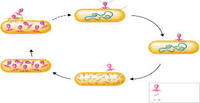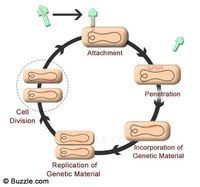
AP Bio - Viral Genome
Quiz
•
Science
•
11th Grade
•
Practice Problem
•
Easy
Kristina Donaldson
Used 11+ times
FREE Resource
Enhance your content in a minute
20 questions
Show all answers
1.
MULTIPLE CHOICE QUESTION
1 min • 1 pt
Which viral cycle takes the longest to show symptoms?
Lysogenic
Lytic
2.
MULTIPLE CHOICE QUESTION
1 min • 1 pt
What is the first step to both cycles?
The virus attaches to a host
the virus injects genetic material
the host gets sick
the cell is destroyed
3.
MULTIPLE CHOICE QUESTION
1 min • 1 pt
When the viral DNA becomes active in the lysogenic cycle, which life cycle does it enter?
lytic
lysogenic
cell cycle
DNA replication
4.
MULTIPLE CHOICE QUESTION
30 sec • 1 pt

What is shown here?
5.
MULTIPLE CHOICE QUESTION
30 sec • 1 pt

What process is this?
6.
MULTIPLE CHOICE QUESTION
30 sec • 1 pt
What happens in the lysogenic cycle?
7.
MULTIPLE CHOICE QUESTION
30 sec • 1 pt
Viruses contain genetic material which carries the instructions for the construction of new virus particles. This genetic material is primarily composed of-
phospholipids
polysaccharides
nucleic acids
polypeptides
Create a free account and access millions of resources
Create resources
Host any resource
Get auto-graded reports

Continue with Google

Continue with Email

Continue with Classlink

Continue with Clever
or continue with

Microsoft
%20(1).png)
Apple
Others
Already have an account?
Similar Resources on Wayground

15 questions
Life Cycle of Animals
Quiz
•
4th Grade - University

17 questions
Glossary - Protein Synthesis
Quiz
•
6th - 12th Grade

15 questions
MIKROORGANISMA
Quiz
•
11th - 12th Grade

15 questions
Quiz: NonRenewable vs. Renewable Energy
Quiz
•
5th Grade - University

15 questions
QUIZ 2 ELS
Quiz
•
11th Grade

20 questions
Science Week Brain Break Activity
Quiz
•
7th - 12th Grade

15 questions
Heredity and Traits Review
Quiz
•
7th Grade - University

15 questions
Plant cells - Team 1
Quiz
•
10th Grade - University
Popular Resources on Wayground

5 questions
This is not a...winter edition (Drawing game)
Quiz
•
1st - 5th Grade

15 questions
4:3 Model Multiplication of Decimals by Whole Numbers
Quiz
•
5th Grade

25 questions
Multiplication Facts
Quiz
•
5th Grade

10 questions
The Best Christmas Pageant Ever Chapters 1 & 2
Quiz
•
4th Grade

12 questions
Unit 4 Review Day
Quiz
•
3rd Grade

10 questions
Identify Iconic Christmas Movie Scenes
Interactive video
•
6th - 10th Grade

20 questions
Christmas Trivia
Quiz
•
6th - 8th Grade

18 questions
Kids Christmas Trivia
Quiz
•
KG - 5th Grade
Discover more resources for Science

100 questions
Biology EOC Review
Quiz
•
9th - 12th Grade

82 questions
Final Exam
Quiz
•
9th - 12th Grade

12 questions
CFA #3 Cellular Respiration
Quiz
•
9th - 12th Grade

18 questions
Identify Functions of Body Systems
Quiz
•
9th - 12th Grade

75 questions
Ducks Unlimited Cert Review
Quiz
•
9th - 12th Grade

20 questions
Reading Graphs in Science
Quiz
•
9th - 12th Grade

34 questions
Health Science 1: Final Exam Review #1
Quiz
•
10th - 12th Grade

15 questions
Carrying Capacity and Limiting Factors
Quiz
•
9th - 12th Grade
